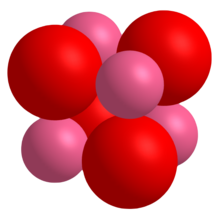| Revision as of 22:15, 30 June 2022 editCitation bot (talk | contribs)Bots5,439,381 edits Add: issue, bibcode, pmid. | Use this bot. Report bugs. | Suggested by Abductive | Category:Multiple chemicals in an infobox that need indexing | #UCB_Category 1017/1863← Previous edit | Revision as of 19:05, 29 March 2023 edit undoTwinsday (talk | contribs)Extended confirmed users, Pending changes reviewers22,612 editsm add linksTags: Mobile edit Mobile app edit iOS app editNext edit → | ||
| Line 69: | Line 69: | ||
| }} | }} | ||
| '''Cobalt(II) oxide''' is an inorganic compound that has been described as an olive-green<ref name=G&E/> or gray<ref name=Ullmann/> solid. It is used extensively in the ]s industry as an additive to create blue |
'''Cobalt(II) oxide''' is an ] that has been described as an ]<ref name=G&E/> or ]<ref name=Ullmann/> ]. It is used extensively in the ]s industry as an additive to create blue-colored ] and ], as well as in the chemical industry for producing cobalt(II) salts. A related material is ], a black solid with the ] Co<sub>3</sub>O<sub>4</sub>. | ||
| == Structure and properties == | == Structure and properties == | ||
Revision as of 19:05, 29 March 2023
"CoO" redirects here. For other uses, see COO (disambiguation).
| |
| Names | |
|---|---|
| IUPAC name Cobalt(II) oxide | |
| Other names
Cobaltous oxide Cobalt monoxide | |
| Identifiers | |
| CAS Number | |
| 3D model (JSmol) | |
| ChemSpider | |
| ECHA InfoCard | 100.013.777 |
| EC Number |
|
| PubChem CID | |
| RTECS number |
|
| UNII | |
| UN number | 3288 |
| CompTox Dashboard (EPA) | |
InChI
| |
SMILES
| |
| Properties | |
| Chemical formula | CoO |
| Molar mass | 74.9326 g/mol |
| Appearance | olive or gray powder |
| Odor | odorless |
| Density | 6.45 g/cm |
| Melting point | 1,933 °C (3,511 °F; 2,206 K) |
| Solubility in water | insoluble in water |
| Magnetic susceptibility (χ) | +4900.0·10 cm/mol |
| Structure | |
| Crystal structure | cubic, cF8 |
| Space group | Fm3m, No. 225 |
| Hazards | |
| GHS labelling: | |
| Pictograms |  
|
| Signal word | Warning |
| Hazard statements | H302, H317, H410 |
| Precautionary statements | P260, P280, P284, P301+P310+P330, P304+P340+P310, P342+P311, P403+P233 |
| NFPA 704 (fire diamond) |
 |
| Flash point | Non-flammable |
| Lethal dose or concentration (LD, LC): | |
| LD50 (median dose) | 202 mg/kg |
| Safety data sheet (SDS) | ICSC 1551 |
| Related compounds | |
| Other anions | Cobalt(II) sulfide Cobalt(II) hydroxide |
| Other cations | Iron(II) oxide Nickel(II) oxide |
| Related compounds | Cobalt(II,III) oxide Cobalt(III) oxide |
| Except where otherwise noted, data are given for materials in their standard state (at 25 °C , 100 kPa).
| |
Cobalt(II) oxide is an inorganic compound that has been described as an olive-green or gray solid. It is used extensively in the ceramics industry as an additive to create blue-colored glazes and enamels, as well as in the chemical industry for producing cobalt(II) salts. A related material is cobalt(II,III) oxide, a black solid with the formula Co3O4.
Structure and properties
CoO crystals adopt the periclase (rock salt) structure with a lattice constant of 4.2615 Å.
It is antiferromagnetic below 16 °C.
Preparation
Cobalt(II) oxide is prepared by oxidation of cobalt powder with air or by thermal decomposition of cobalt(II) nitrate or the carbonate.
Cobalt(II,III) oxide decomposes to cobalt(II) oxide at 950 °C:
- 2 Co3O4 → 6 CoO + O2
It may also be prepared by precipitating the hydroxide, followed by thermal dehydration:
- CoX2 + 2 KOH → Co(OH)2 + 2 KX
- Co(OH)2 → CoO + H2O
Reactions
As can be expected, cobalt(II) oxide reacts with mineral acids to form the corresponding cobalt salts:
- CoO + 2 HX → CoX2 + H2O
Applications
Cobalt(II) oxide has for centuries been used as a coloring agent on kiln fired pottery. The additive provides a deep shade of blue named cobalt blue. The band gap (CoO) is around 2.4 eV. It also is used in cobalt blue glass.
See also
References
- Lide, David R., ed. (2006). CRC Handbook of Chemistry and Physics (87th ed.). Boca Raton, Florida: CRC Press. ISBN 0-8493-0487-3.
- Advanced Search – Alfa Aesar – A Johnson Matthey Company Archived 2011-07-19 at the Wayback Machine. Alfa.com. Retrieved on 2011-11-19.
- ^ Greenwood, Norman N.; Earnshaw, Alan (1997). Chemistry of the Elements (2nd ed.). Butterworth-Heinemann. ISBN 978-0-08-037941-8.
- ^ Donaldson, John Dallas; Beyersmann, Detmar (2005). "Cobalt and Cobalt Compounds". Ullmann's Encyclopedia of Industrial Chemistry. Weinheim: Wiley-VCH. doi:10.1002/14356007.a07_281.pub2. ISBN 978-3527306732.
- Kannan, R.; Seehra, Mohindar S. (1987). "Percolation effects and magnetic properties of the randomly diluted fcc system CopMg1-pO". Physical Review B. 35 (13): 6847–6853. Bibcode:1987PhRvB..35.6847K. doi:10.1103/PhysRevB.35.6847. PMID 9940938.
- Silinsky, P. S.; Seehra, Mohindar S. (1981). "Principal magnetic susceptibilities and uniaxial stress experiments in CoO". Physical Review B. 24 (1): 419–423. Bibcode:1981PhRvB..24..419S. doi:10.1103/PhysRevB.24.419.
- US 4389339, James, Leonard E.; Crescentini, Lamberto & Fisher, William B., "Process for making a cobalt oxide catalyst", published 1983-06-21
| Cobalt compounds | |
|---|---|
| Cobalt(I) | |
| Cobalt(II) | |
| Cobalt(0,III) | |
| Cobalt(II,III) | |
| Cobalt(III) | |
| Cobalt(III,IV) | |
| Cobalt(IV) | |
| Cobalt(V) | |